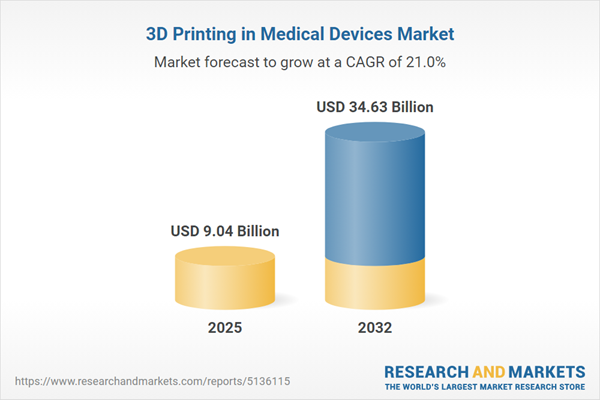Speak directly to the analyst to clarify any post sales queries you may have.
Senior healthcare executives face a dynamic era in which three-dimensional printing is redefining the possibilities for medical device innovation, precision patient care, and operational flexibility—demanding actionable intelligence for strategic investments in technology and supply chains.
Market Snapshot: 3D Printing in Medical Devices Market
The 3D Printing in Medical Devices Market grew from USD 7.54 billion in 2024 to USD 9.04 billion in 2025. It is projected to achieve a CAGR of 20.99%, reaching USD 34.63 billion by 2032.
This growth trajectory underscores accelerated adoption across hospitals, manufacturers, and research centers, as additive manufacturing transitions from a prototyping tool to an integrated production solution within healthcare.Scope & Segmentation
This market research provides a detailed analysis across leading segments and regions, ensuring targeted insight for operational and investment decisions:
- Offerings: Printers, Services, Software
- Technologies: Digital Light Processing, Electron Beam Melting, Fused Deposition Modeling, Selective Laser Sintering, Stereolithography
- Medical Devices: Diagnostic Devices (Lab Equipment, Point-of-Care Testing Devices), Drug Delivery Devices, Prosthetics & Implants (Cranial, Dental, Orthopedic), Surgical Instruments (Surgical Fasteners, Guides, Scalpels), Tissue Engineering Products
- Material Types: Ceramics, Composites, Metals
- End-Users: Hospitals & Surgical Centers, Medical Device Manufacturers, Research & Academic Institutions
- Regions: Americas (North America, Latin America), Europe, Middle East & Africa (Europe, Middle East, Africa), Asia-Pacific (China, India, Japan, Australia, South Korea, Indonesia, Thailand, Malaysia, Singapore, Taiwan)
- Key Companies: 3D Systems Corporation, Abbott Laboratories, Anatomics Pty Ltd., Anisoprint SARL, Apium Additive Technologies GmbH, Arkema SA, BICO Group AB, Biomedical Modeling Inc., Carbon Inc., EOS GmbH, Evonik Industries AG, Formlabs Inc., GE HealthCare Technologies Inc., Henkel AG & Co. KGaA, Johnson & Johnson Services Inc., Materialise NV, Organovo Holdings Inc., Prodways Group, Proto Labs Inc., RapidMade Inc., Renishaw PLC, Restor3d Inc., Siemens AG, SLM Solutions Group AG, Smith & Nephew PLC, Solvay S.A., Stratasys Ltd., Stryker Corporation, Thermo Fisher Scientific Inc., Zimmer Biomet Holdings Inc., Zortrax S.A.
Key Takeaways for Decision-Makers
- 3D printing enables the manufacture of patient-specific devices, supporting greater customization and improved procedural outcomes.
- Technological convergence, such as AI-powered design software and advanced materials, accelerates the shift from prototyping to scalable, production-grade solutions.
- Collaboration among OEMs, service bureaus, and research institutions is crucial for integrating design, validation, and regulatory compliance workflows.
- Segment-specific strategies are essential, as adoption dynamics and performance requirements differ between prosthetics, surgical instruments, diagnostics, and tissue engineering products.
- Geographic expansion and local partnerships are vital, given varying regulatory frameworks and infrastructure maturity across global regions.
- Adoption of digital inventory and analytics solutions strengthens operational resilience and demand forecasting in a flexible supply chain environment.
Tariff Impact on Supply Chain and Sourcing Strategies
The introduction of United States tariffs in 2025 on imported metals, ceramics, and specialized polymers has transformed sourcing decisions for medical device 3D printing. Many manufacturers are diversifying material procurement, seeking local or regional suppliers to mitigate the effects of increased input costs. These adjustments are influencing operational models, with providers investing in digital tracking and just-in-time production to reduce excess inventory and enhance resilience. Strategic alliances between OEMs and domestic material partners are emerging as a response to price volatility, supporting both cost control and regulatory compliance.
Primary and Secondary Keyword Integration
This analysis places the primary keyword—3D Printing in Medical Devices Market—at the forefront, with secondary keywords seamlessly enhancing context and discoverability for related market research and technology adoption strategies.
Methodology & Data Sources
Research findings are grounded in rigorous primary interviews with senior executives from OEMs, service providers, software vendors, and healthcare institutions. Secondary sources include peer-reviewed literature, industry reports, patent data, and case studies. Triangulation of quantitative and qualitative inputs ensures robust, actionable insights for stakeholders.
Why This Report Matters
- Delivers actionable intelligence to streamline investment decisions—aligning technology adoption with evolving clinical and operational demands.
- Equips stakeholders with critical understanding of segmentation, tariff influences, and supply chain strategies in a rapidly evolving healthcare market.
- Supports informed planning for cross-border initiatives, material innovation, and regulatory navigation based on regional dynamics.
Conclusion
This report provides an evidence-based view of how additive manufacturing is transforming medical device production worldwide. It offers senior leaders a strategic foundation to capture value through innovation, partnerships, and operational adaptability.
Additional Product Information:
- Purchase of this report includes 1 year online access with quarterly updates.
- This report can be updated on request. Please contact our Customer Experience team using the Ask a Question widget on our website.
Table of Contents
3. Executive Summary
4. Market Overview
7. Cumulative Impact of Artificial Intelligence 2025
Companies Mentioned
The companies profiled in this 3D Printing in Medical Devices market report include:- 3D Systems Corporation
- Abbott Laboratories
- Anatomics Pty Ltd.
- Anisoprint SARL
- Apium Additive Technologies GmbH
- Arkema SA
- BICO Group AB
- Biomedical Modeling Inc.
- Carbon, Inc.
- EOS GmbH
- Evonik Industries AG
- Formlabs Inc.
- GE HealthCare Technologies Inc.
- Henkel AG & Co. KGaA
- Johnson & Johnson Services, Inc.
- Materialise NV
- Organovo Holdings Inc.
- Prodways Group
- Proto Labs, Inc.
- RapidMade Inc.
- Renishaw PLC
- Restor3d, Inc.
- Siemens AG
- SLM Solutions Group AG
- Smith & Nephew PLC
- Solvay S.A.
- Stratasys Ltd.
- Stryker Corporation
- Thermo Fisher Scientific Inc.
- Zimmer Biomet Holdings, Inc.
- Zortrax S.A.
Table Information
| Report Attribute | Details |
|---|---|
| No. of Pages | 180 |
| Published | November 2025 |
| Forecast Period | 2025 - 2032 |
| Estimated Market Value ( USD | $ 9.04 Billion |
| Forecasted Market Value ( USD | $ 34.63 Billion |
| Compound Annual Growth Rate | 20.9% |
| Regions Covered | Global |
| No. of Companies Mentioned | 32 |









